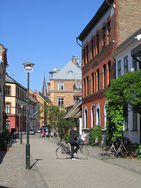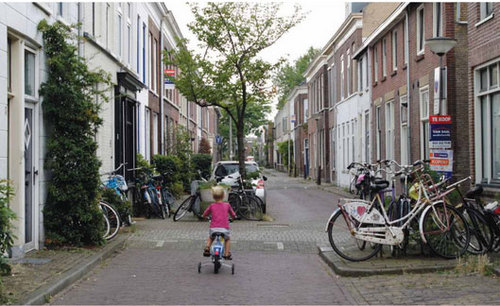Woonerfs were tactical urbanism before there was “tactical urbanism”
Tactical urbanism is about using low-cost, temporary changes to the built environment to make places better. Mike Lydon, co-author of Tactical Urbanism: Short Term Action for Long Term Change, will join us for a book talk on April 21. In advance of the event, we’re reprinting a few adapted excerpts from the book. This one explains how the woonerf is a historic inspiration for modern tactical urbanism.
It would be nice to believe that we’ve discovered some entirely new form of urbanism, but the truth is that the impulse to create temporary or low-cost responses to the challenges of urban life is not new.
Here, we have reframed a set of core placemaking values (temporary, low-cost, flexible, iterative, participatory) found throughout history and updated them for the digital age.
From provisional Roman military encampments, to les bouquinistes illegally selling books along the banks of the Seine in sixteenth-century Paris, to the temporary White City of the Chicago World’s Fair of 1892, the hallmarks of Tactical Urbanism have been inscribed in city-building patterns throughout history.
Ultimately, Tactical Urbanism describes the latest response to our basic human instincts: incremental and self-directed action toward increasing social capital, economic opportunity, access to food, safety from natural and human enemies, and general livability.
Human ingenuity aimed at improving urban life knows no profession, sector, or points along a historical timeline. We’ll always have unmet needs and unexploited opportunities to enhance urban living. Those who address them directly, creatively, and efficiently will continue to guide us in the twenty-first century.
The woonerf
The Dutch woonerf — a street that accommodates pedestrians, bicyclists, and people recreating, in addition to cars — was first developed by residents who took it upon themselves to slow traffic in their neighborhood.
The invention of the Dutch woonerf stands out because unlike many street design innovations from the last 100 years, it did not originate from the profession of traffic engineering but from citizens seeking to slow traffic in their community.
Dutch for “living yard,” the woonerf is a residential street where people who are not in cars are given priority over people who are. This is accomplished by using physical design to slow drivers down to a near walking speed so as to not crash into strategically placed trees, bollards, bike racks, and other amenities.
The woonerf was created when a group of residents in the Dutch city of Delft grew frustrated with the growing problems related to safety, congestion, and pollution as car use increased in their compact and otherwise walkable city.6 The municipality’s lack of response inspired a group of neighbors to tear up portions of the pavement on their street in the middle of the night so that cars had to maneuver around the resulting obstruction at low speed.
This citizen-led, bottom-up initiative introduced a new street type to international audiences, one that returned the street to the citizens for playing, walking, and bicycling and did not give the automobile priority.
With little evidence that the intervention disrupted daily life, the municipal government quietly ignored the citizen-led initiative and advocates pursued its formal acceptance. In 1976 the Dutch Parliament passed regulations incorporating the woonerven (plural) into the national street design standards.
Today the woonerf, or a similar form of shared space, is an increasingly accepted traffic-calming measure outside North America, and it is understood by international bodies using standards and engineering practices based on common professional practice.
The international acceptance of the woonerf demonstrates how unsanctioned, grassroots activity can become sanctioned by bodies of government over time.
Read more in chapter 2 of Tactical Urbanism, and RSVP for the talk on April 21.




